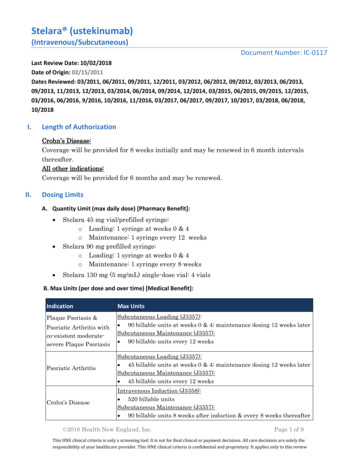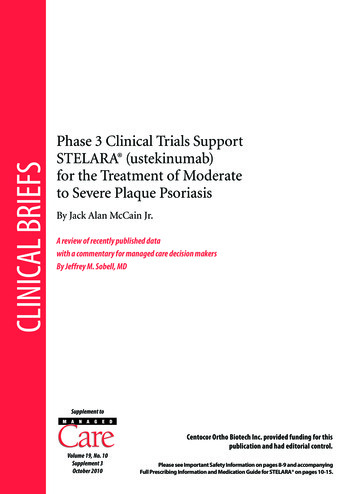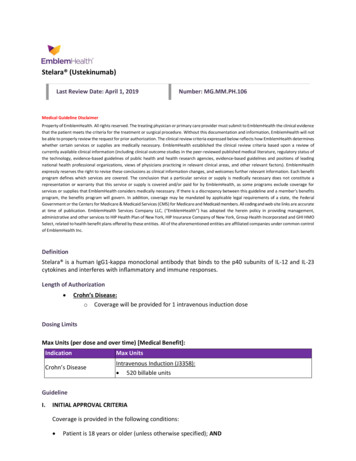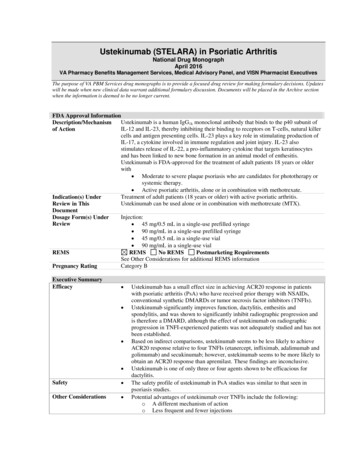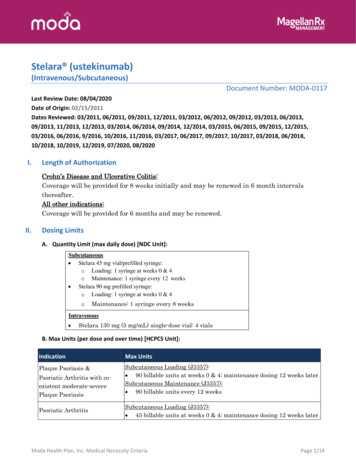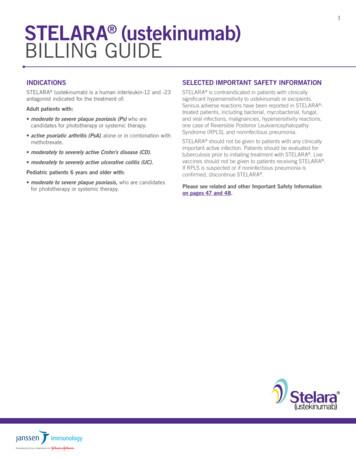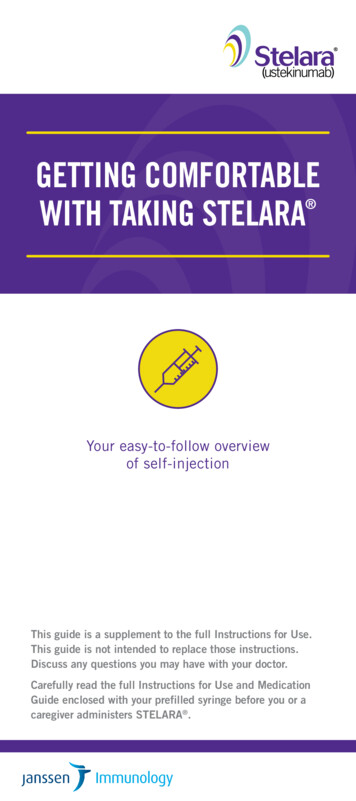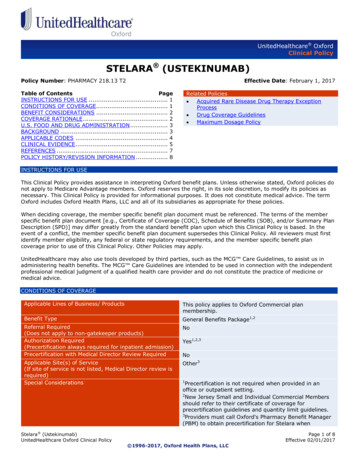
Transcription
OxfordUnitedHealthcare OxfordClinical PolicySTELARA (USTEKINUMAB)Policy Number: PHARMACY 218.13 T2Effective Date: February 1, 2017Table of ContentsPageINSTRUCTIONS FOR USE . 1CONDITIONS OF COVERAGE. 1BENEFIT CONSIDERATIONS . 2COVERAGE RATIONALE . 2U.S. FOOD AND DRUG ADMINISTRATION . 3BACKGROUND . 3APPLICABLE CODES . 4CLINICAL EVIDENCE . 5REFERENCES . 7POLICY HISTORY/REVISION INFORMATION . 8Related Policies Acquired Rare Disease Drug Therapy ExceptionProcess Drug Coverage Guidelines Maximum Dosage PolicyINSTRUCTIONS FOR USEThis Clinical Policy provides assistance in interpreting Oxford benefit plans. Unless otherwise stated, Oxford policies donot apply to Medicare Advantage members. Oxford reserves the right, in its sole discretion, to modify its policies asnecessary. This Clinical Policy is provided for informational purposes. It does not constitute medical advice. The termOxford includes Oxford Health Plans, LLC and all of its subsidiaries as appropriate for these policies.When deciding coverage, the member specific benefit plan document must be referenced. The terms of the memberspecific benefit plan document [e.g., Certificate of Coverage (COC), Schedule of Benefits (SOB), and/or Summary PlanDescription (SPD)] may differ greatly from the standard benefit plan upon which this Clinical Policy is based. In theevent of a conflict, the member specific benefit plan document supersedes this Clinical Policy. All reviewers must firstidentify member eligibility, any federal or state regulatory requirements, and the member specific benefit plancoverage prior to use of this Clinical Policy. Other Policies may apply.UnitedHealthcare may also use tools developed by third parties, such as the MCG Care Guidelines, to assist us inadministering health benefits. The MCG Care Guidelines are intended to be used in connection with the independentprofessional medical judgment of a qualified health care provider and do not constitute the practice of medicine ormedical advice.CONDITIONS OF COVERAGEApplicable Lines of Business/ ProductsThis policy applies to Oxford Commercial planmembership.Benefit TypeGeneral Benefits Package1,2Referral Required(Does not apply to non-gatekeeper products)Authorization Required(Precertification always required for inpatient admission)Precertification with Medical Director Review RequiredNoApplicable Site(s) of Service(If site of service is not listed, Medical Director review isrequired)Special ConsiderationsOther3Stelara (Ustekinumab)UnitedHealthcare Oxford Clinical PolicyYes1,2,3No1Precertification is not required when provided in anoffice or outpatient setting.2New Jersey Small and Individual Commercial Membersshould refer to their certificate of coverage forprecertification guidelines and quantity limit guidelines.3Providers must call Oxford's Pharmacy Benefit Manager(PBM) to obtain precertification for Stelara when 1996-2017, Oxford Health Plans, LLCPage 1 of 8Effective 02/01/2017
Special Considerationsobtained at a pharmacy for self-administration. Refer tothe policy titled Drug Coverage Guidelines.(continued)BENEFIT CONSIDERATIONSBefore using this policy, please check the member specific benefit plan document and any federal or state mandates,if applicable.Some Certificates of Coverage allow coverage of experimental/investigational/unproven treatments for life-threateningillnesses when certain conditions are met. The member specific benefit plan document must be consulted to makecoverage decisions for this service. Some states mandate benefit coverage for off-label use of medications for somediagnoses or under some circumstances when certain conditions are met. Where such mandates apply, theysupersede language in the member specific benefit plan document or in the Medical or Drug Policy. Benefit coveragefor an otherwise unproven service for the treatment of serious rare diseases may occur when certain conditions aremet; refer to the policy titled Acquired Rare Disease Drug Therapy Exception Process.Essential Health Benefits for Individual and Small GroupFor plan years beginning on or after January 1, 2014, the Affordable Care Act of 2010 (ACA) requires fully insurednon-grandfathered individual and small group plans (inside and outside of Exchanges) to provide coverage for tencategories of Essential Health Benefits (“EHBs”). Large group plans (both self-funded and fully insured), and smallgroup ASO plans, are not subject to the requirement to offer coverage for EHBs. However, if such plans choose toprovide coverage for benefits which are deemed EHBs, the ACA requires all dollar limits on those benefits to beremoved on all Grandfathered and Non-Grandfathered plans. The determination of which benefits constitute EHBs ismade on a state by state basis. As such, when using this policy, it is important to refer to the member specific benefitplan document to determine benefit coverage.COVERAGE RATIONALEThis policy refers to Stelara (ustekinumab) injection.Stelara is proven and medically necessary for the treatment of: Crohn’s disease when all of the following criteria are met:1o Diagnosis of moderately to severely active Crohn’s disease; ando One of the following: History of failure, contraindication, or intolerance to at least one tumor necrosis factor (TNF) blocker[e.g., Remicade/Inflectra (infliximab), Humira (adalimumab), Cimzia (certolizumab)]; or Both of the following:History of failure, contraindication, or intolerance to at least one immunomodulator or corticosteroid(e.g., corticosteroids, 6-mercaptopurine, azathioprine, methotrexate, etc.)Patient has never failed a TNF blocker [e.g., Remicade/Inflectra (infliximab), Humira (adalimumab),Cimzia (certolizumab)]ando One of the following:Initial Therapy: Stelara is to be administered as an intravenous induction dose; and Stelara induction dosing is accordance with the United States Food and Drug Administration approvedlabeled dosing for Crohn’s disease:260mg for patients weighing 55kg390mg for patients weighing 55kg to 85kg520mg for patients weighing 85kgand Patient is not receiving Stelara in combination with any of the following:Biologic DMARD [e.g., Remicade/Inflectra (infliximab), Humira (adalimumab), Cimzia (certolizumab),Simponi (golimumab)]Janus kinase inhibitor [e.g., Xeljanz (tofacitinib)]16Phosphodiesterase 4 (PDE4) inhibitor [e.g., Otezla (apremilast)]and Authorization will be for one induction doseORo Continuation Therapy: Patient is unable to self-administer subcutaneous doses; and Stelara is to be subcutaneously administered 8 weeks after the initial intravenous dose; andStelara (Ustekinumab)UnitedHealthcare Oxford Clinical Policy 1996-2017, Oxford Health Plans, LLCPage 2 of 8Effective 02/01/2017
Stelara continuation dosing is in accordance with the United States Food and Drug Administrationapproved labeled dosing for Crohn’s disease:90mg every 8 weeks subcutaneouslyandPatient is not receiving Stelara in combination with any of the following:Biologic DMARD [e.g., Remicade/Inflectra (infliximab), Humira (adalimumab), Cimzia (certolizumab),Simponi (golimumab)]Janus kinase inhibitor [e.g., Xeljanz (tofacitinib)]16Phosphodiesterase 4 (PDE4) inhibitor [e.g., Otezla (apremilast)] Plaque psoriasis when all of the following criteria are met:1o Diagnosis of moderate to severe plaque psoriasis; ando One of the following: Patient is a candidate for phototherapy Patient is a candidate for systemic therapyando Patient is unable to self-administer subcutaneous doses; ando Stelara is initiated and titrated according to US Food and Drug Administration labeled dosing for plaquepsoriasis up to a maximum of (or equivalent dose and interval schedule): 45mg every 12 weeks for patients weighing 100kg subcutaneously 90mg every 12 weeks for patients weighing 100kg subcutaneouslyando Patient is not receiving Stelara in combination with any of the following: Biologic DMARD [e.g., Enbrel (etanercept), Humira (adalimumab), Cimzia (certolizumab), Simponi(golimumab)] Janus kinase inhibitor [e.g., Xeljanz (tofacitinib)]16 Phosphodiesterase 4 (PDE4) inhibitor [e.g., Otezla (apremilast)] Psoriatic arthritis when all of the following criteria are met:1o Diagnosis of psoriatic arthritis; ando Stelara is initiated and titrated according to US Food and Drug Administration labeled dosing for psoriaticarthritis up to a maximum of 90mg every 12 weeks subcutaneously (or equivalent dose and intervalschedule); ando Patient is unable to self-administer subcutaneous doses; ando Patient is not receiving Stelara in combination with any of the following: Biologic DMARD [e.g., Enbrel (etanercept), Humira (adalimumab), Cimzia (certolizumab), Simponi(golimumab)] Janus kinase inhibitor [e.g., Xeljanz (tofacitinib)]16 Phosphodiesterase 4 (PDE4) inhibitor [e.g., Otezla (apremilast)]Stelara is unproven and not medically necessary for the treatment of: Multiple sclerosisIn available studies, ustekinumab does not demonstrate efficacy in the treatment of multiple sclerosis.U.S. FOOD AND DRUG ADMINISTRATION (FDA)Stelara is a human interleukin-12 and -23 antagonist indicated for the treatment of adult patients (18 years or older)with:1 Moderate to severe plaque psoriasis who are candidates for phototherapy or systemic therapy, Active psoriatic arthritis, alone or in combination with methotrexate. Moderately to severely active Crohn’s disease who have:o Failed or were intolerant to treatment with immunomodulators or corticosteroids, but never failed a tumornecrosis factor (TNF) blocker oro Failed or were intolerant to treatment with one or more TNF blockersBACKGROUNDStelara is a human IgG1κ monoclonal antibody that binds with high affinity and specificity to the p40 protein subunitused by both the interleukin (IL)-12 and IL-23 naturally occurring cytokines. IL-12 and IL-23 are involved ininflammatory and immune responses, such as natural killer cell activation and CD4 T-cell differentiation andactivation.1Stelara (Ustekinumab)UnitedHealthcare Oxford Clinical Policy 1996-2017, Oxford Health Plans, LLCPage 3 of 8Effective 02/01/2017
APPLICABLE CODESThe following list(s) of procedure and/or diagnosis codes is provided for reference purposes only and may not be allinclusive. Listing of a code in this policy does not imply that the service described by the code is a covered or noncovered health service. Benefit coverage for health services is determined by the member specific benefit plandocument and applicable laws that may require coverage for a specific service. The inclusion of a code does not implyany right to reimbursement or guarantee claim payment. Other Policies may apply.HCPCS CodeJ3357*DescriptionUstekinumab, for subcutaneous injection, 1 mg*Intravenous administration to be billed under J3590 until a J or Q code is assigned.ICD-10 Diagnosis CodeK50.00DescriptionCrohn's disease of small intestine without complicationsK50.011Crohn's disease of small intestine with rectal bleedingK50.012Crohn's disease of small intestine with intestinal obstructionK50.013Crohn's disease of small intestine with fistulaK50.014Crohn's disease of small intestine with abscessK50.018Crohn's disease of small intestine with other complicationK50.019Crohn's disease of small intestine with unspecified complicationsK50.10Crohn's disease of large intestine without complicationsK50.111Crohn's disease of large intestine with rectal bleedingK50.112Crohn's disease of large intestine with intestinal obstructionK50.113Crohn's disease of large intestine with fistulaK50.114Crohn's disease of large intestine with abscessK50.118Crohn's disease of large intestine with other complicationK50.119Crohn's disease of large intestine with unspecified complicationsK50.80Crohn's disease of both small and large intestine without complicationsK50.811Crohn's disease of both small and large intestine with rectal bleedingK50.812Crohn's disease of both small and large intestine with intestinal obstructionK50.813Crohn's disease of both small and large intestine with fistulaK50.814Crohn's disease of both small and large intestine with abscessK50.818Crohn's disease of both small and large intestine with other complicationK50.819Crohn's disease of both small and large intestine with unspecified complicationsK50.90Crohn's disease, unspecified, without complicationsK50.911Crohn's disease, unspecified, with rectal bleedingK50.912Crohn's disease, unspecified, with intestinal obstructionK50.913Crohn's disease, unspecified, with fistulaK50.914Crohn's disease, unspecified, with abscessK50.918Crohn's disease, unspecified, with other complicationK50.919Crohn's disease, unspecified, with unspecified complicationsL40.0Psoriasis vulgarisL40.1Generalized pustular psoriasisL40.2Acrodermatitis continuaL40.3Pustulosis palmaris et plantarisL40.4Guttate psoriasisL40.50Arthropathic psoriasis, unspecifiedL40.51Distal interphalangeal psoriatic arthropathyL40.52Psoriatic arthritis mutilansL40.53Psoriatic spondylitisStelara (Ustekinumab)UnitedHealthcare Oxford Clinical Policy 1996-2017, Oxford Health Plans, LLCPage 4 of 8Effective 02/01/2017
ICD-10 Diagnosis CodeL40.54L40.59DescriptionPsoriatic juvenile arthropathyOther psoriatic arthropathyL40.8Other psoriasisL40.9Psoriasis, unspecifiedCLINICAL EVIDENCEProven/Medically NecessaryCrohn’s DiseaseUstekinumab was evaluated in three randomized, double-blind, placebo-controlled clinical studies in adult patientswith moderately to severely active Crohn's disease. There were two 8-week intravenous induction studies followed bya 44-week subcutaneous randomized withdrawal maintenance study representing 52 weeks of therapy. 1In the two induction studies, 1409 patients were randomized, and 1368 (CD-1, n 741; CD-2, n 627) were includedin the final efficacy analysis. Induction of clinical response at Week 6 and clinical remission at Week 8 were primaryendpoints. In both studies, patients were randomized to receive a single intravenous administration of ustekinumab ateither approximately 6 mg/kg, placebo, or 130 mg. In the first study, patients had failed or were intolerant to priortreatment with a TNF blocker: 29% patients had an inadequate initial response (primary non-responders), 69%responded but subsequently lost response (secondary non-responders) and 36% were intolerant to a TNF blocker. Ofthese patients, 48% failed or were intolerant to one TNF blocker and 52% had failed 2 or 3 prior TNF blockers. Atbaseline and throughout this study, approximately 46% of the patients were receiving corticosteroids and 31% of thepatients were receiving immunomodulators (azathioprine, 6-mercaptopurine, methotrexate). The median baselineCDAI score was 319 in the ustekinumab approximately 6 mg/kg group and 313 in the placebo group.1In the second induction study, patients had failed or were intolerant to prior treatment with corticosteroids (81% ofpatients), at least one immunomodulator; (68% of patients), or both (49% of patients). Additionally, 69% neverreceived a TNF blocker and 31% previously received but had not failed a TNF blocker. At baseline, and throughout thestudy, approximately 39% of the patients were receiving corticosteroids and 35% of the patients were receivingimmunomodulators. The median baseline CDAI score was 286 in the ustekinumab and 290 in the placebo group.1In both of the induction studies, a greater proportion of patients treated with ustekinumab achieved clinical responseat Week 6 and clinical remission at Week 8 compared to placebo. Clinical response and remission were significant asearly as Week 3 in ustekinumab treated patients and continued to improve through Week 8. 1The maintenance study, evaluated 388 patients who achieved clinical response ( 100 point reduction in CDAI score)at Week 8 of induction with ustekinumab in either of the induction studies. Patients were randomized to receive asubcutaneous maintenance regimen of either 90 mg ustekinumab every 8 weeks or placebo for 44 weeks (see Table10).1At Week 44, 47% of patients who received ustekinumab were corticosteroid-free and in clinical remission, comparedto 30% of patients in the placebo group. At Week 0 of this study, 34/56 (61%) ustekinumab treated patients whopreviously failed or were intolerant to TNF blocker therapies were in clinical remission and 23/56 (41%) of thesepatients were in clinical remission at Week 44. In the placebo arm, 27/61 (44%) patients were in clinical remission atWeek 0 while 16/61 (26%) of these patients were in remission at Week 44. At Week 0 of this study, 46/72 (64%)ustekinumab treated patients who had previously failed immunomodulator therapy or corticosteroids (but not TNFblockers) were in clinical remission and 45/72 (63%) of these patients were in clinical remission at Week 44. In theplacebo arm, 50/70 (71%) of these patients were in clinical remission at Week 0 while 31/70 (44%) were in remissionat Week 44. In the subset of these patients who were also naïve to TNF blockers, 34/52 (65%) of ustekinumabtreated patients were in clinical remission at Week 44 as compared to 25/51 (49%) in the placebo arm. Patients whowere not in clinical response 8 weeks after ustekinumab induction were not included in the primary efficacy analyses;however, these patients were eligible to receive a 90 mg subcutaneous injection of ustekinumab upon entry into themaintenance study. Of these patients, 102/219 (47%) achieved clinical response eight weeks later and were followedfor the duration of the study.1Plaque PsoriasisA phase 3, multi-center, double-blind, placebo-controlled, randomized study evaluated the safety and efficacy ofustekinumab in patients age 12 to 17 years who had moderate-to-severe psoriasis.17 Patients (n 110) wererandomly assigned (2:2:1:1) ratio to ustekinumab (SD; 0.75 mg/kg [ 60 kg], 45 mg [ 60 - 100 kg], and 90 mg[ 100 kg]) or half-standard dosing (HSD; 0.375 mg/kg [ 60 kg], 22.5 mg [ 60 - 100 kg], and 45 mg [ 100 kg])at weeks 0 and 4 and every 12 weeks or placebo at weeks 0 and 4 with crossover to ustekinumab SD or HSD atStelara (Ustekinumab)UnitedHealthcare Oxford Clinical Policy 1996-2017, Oxford Health Plans, LLCPage 5 of 8Effective 02/01/2017
weeks 12 and 16 and thereafter every 12 weeks through week 40. At week 8, patients with a PASI increase 50%from baseline were eligible to commence treatment with moderate-to-high potency topical steroid preparationsthrough week 12. The primary endpoint was the proportion of patients with a Physician’s Global Assessment (PGA)0/1 at week 12. Major secondary endpoints were the proportions of patients achieving at least 75% improvement inPASI (PASI 75) and at least 90% improvement in PASI (PASI 90) at week 12 and the change from baseline inChildrens’ Dermatology Life Quality Index (CDLQI) at week 12. Assessments were performed through week 52. Atweek 12, the proportions of patients achieving PGA 0/1 were significantly greater in the HSD (67.6%) and SD(69.4%) groups versus placebo (5.4%; P 0.001 for both dose groups). Approximately one-third of patients in eachustekinumab group achieved PGA 0/1 at week 4. Significantly greater proportions of patients in the HSD (32.4%) andSD (47.2%) groups achieved a PGA of 0 at week 12 compared to placebo (2.7%, bot P 0.001). Significantly greaterproportions of patients receiving ustekinumab achieved PASI 75 (HSD, 78.4%; SD, 80.6%; placebo, 10.8%; P 0.001) or PASI 90 (HSD, 54.1%; SD, 61.1%; placebo, 5.4%; P 0.001). Additionally, 21.6% of patients in the HSDgroup and 38.9% in the SD group achieved a PASI score of 0 (cleared) at week 12 compared with 2.7% in theplacebo group (P .014 and P 0.001, respectivel
The inclusion of a code does not imply any right to reimbursement or guarantee claim payment. Other Policies may apply. HCPCS Code Description J3357* Ustekinumab, for subcutaneous injection, 1 mg *Intravenous administration to be billed under J3590 until a J or Q code is ass
